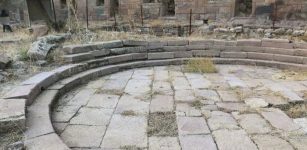How Sæmundur The Wise Tricked The Devil Three Times
Ellen Lloyd -AncientPages.com - Magic is a popular subject in Icelandic folklore. Many stories exist about people who performed extraordinary magical feats and achieved amazing things.
Many ancient books and manuscripts record Icelanders' magical beliefs and practices, which have been preserved for future generations.
One curious story, reflecting a mixture of Christian and Pagan elements, is about how Sæmundur Sigfússon (1056 – 1133) tricked the Devil not just once but three times. Each time, he used a different trick, confusing the Devil.
Aurora over Iceland. Credit: Theo Schacht - CC BY-SA 3.0 DE
Sæmundur Sigfússon, also known as Sæmundur the Learned or Sæmundur the Wise, was a priest who had attended the Black School (Svartiskóli). Whether he studied in France or somewhere in Franconia in northern Bavaria, Germany (formerly a separate duchy of the Holy Roman Empire) is still debated by scholars.
Black School And Dark Arts
Every student who attended the Black School was introduced to the secrets of dark arts. What exactly was taught in this mysterious school remains a subject of debate, but above the entrance to the school, it was written: "You may come in; your soul is lost."
In his book Icelandic Magic: Practical Secrets of the Northern Grimoires, Stephen E. Flowers, director of the Woodharrow Institute for Germanic and Runic Studies, writes that "there was a law in that school that anyone who came must study there for three years. All the ones who were left in any given year had to leave the place at the same time, and the Devil would always keep the one who was last to leave, and so they would always draw lots to see who would be the last one out. More than once the lot fell on Sæmundur, and so he stayed there longer than the law allowed."
Sæmundur Gets A Chance To Escape From The Black School
One day, Sæmundur's life changed, and he was given a chance to leave the Black School. When Bishop Jón, who was on his way to Rome, passed the Black School, he learned that Sæmundur was still trapped there. The Bishop offered Sæmundur an opportunity to escape from the school, but only under the condition that he would become a good Christian when he returned to Iceland. Eager to finally leave the place, Sæmundur accepted the terms.
Bishop Jón was clever and tried to escape unseen with Sæmundur, but the Devil was cunning and noticed the two men were up to something.
"Bishop Jón made Sæmundur walk in front of him, but he wore his cloak loosely over his shoulders, and just when Jón was about to get out, a hand came up through the floor and gripped the cloak and pulled it under, but Jón got out," Flowers relates in his book.
The Devil (fjandinn) made a pact with Sæmundur, who was told he could only leave if he remained hidden for three nights. If Sæmundur failed, he was destined to stay in the Black School with the Devil forever.
Sæmundur was intelligent, and with some help from Bishop, he figured out a way to fool the Devil.
Credit: Public Domain
"The first night Sæmundur hid under a riverbank, both in the water and in the soil at the same time, thus the Devil (Satan) thought that Sæmundur had drowned in the river; the second night he hid out at sea in a shipwreck that was drifting offshore, so the Devil believed that the river must have to spit him out into the sea; the third night he had himself buried in consecrated earth, so the Devil thought that Sæmundur must have been washed ashore dead and been buried in a churchyard, into which he dared not go to seek him. All this was done according to Bishop Jón's advice. "
According to Flowers, another version of the story also describes how Sæmundur fled the school by tricking the Devil with a false leg.
Sæmundur was clever, and he sewed a leg of mutton into his cloak. Then, he followed his fellow students' group, rushing out through the school doors. When Sæmundur was near the exit, the Devil reached up to grab his cloak but only grabbed the leg that was sewn into the clothing. Sæmundur then dropped the cloak and ran, saying: "He grabbed, but I slipped away!"
Snorri Sturluson Was A Student At Oddi
Sæmundur returned to Iceland, and he founded a long-lived school at Oddi, a cultural and learning center during the Middle Ages.
In Iceland, Sæmundur the Wise was regarded as a larger-than-life character. Many prominent persons attended his school at Oddi. One of them was famous historian Snorri Sturluson (1178-1241), and it has been suggested that the name of the Edda, which we always refer to when we discuss Norse mythology, is derived from Oddi.
Written by - Ellen Lloyd – AncientPages.com
Updated on April 15, 2024
Copyright © AncientPages.com All rights reserved. This material may not be published, broadcast, rewritten or redistributed in whole or part without the express written permission of AncientPages.com
More From Ancient Pages
-
 Extraordinary Bronze Age Jewelry Hoard Discovered In A Carrot Field In Switzerland
Archaeology | Oct 18, 2023
Extraordinary Bronze Age Jewelry Hoard Discovered In A Carrot Field In Switzerland
Archaeology | Oct 18, 2023 -
 Denisovans Were First To Adapt To High Altitude And Harsh Conditions Of Tibetan Plateau
Archaeology | May 2, 2019
Denisovans Were First To Adapt To High Altitude And Harsh Conditions Of Tibetan Plateau
Archaeology | May 2, 2019 -
 On This Day In History: Sir Thomas Brisbane, Astronomer, Soldier And Governor Was Born – On July 23, 1773
On This Day In History | Jul 23, 2016
On This Day In History: Sir Thomas Brisbane, Astronomer, Soldier And Governor Was Born – On July 23, 1773
On This Day In History | Jul 23, 2016 -
 Secrets Of Cheops’ Pyramid: Does The Newly Found Chamber Contain An Iron Throne?
Archaeology | Jan 13, 2018
Secrets Of Cheops’ Pyramid: Does The Newly Found Chamber Contain An Iron Throne?
Archaeology | Jan 13, 2018 -
 Scientists Closer To Solving The Mystery Of When Animals Evolved
Evolution | Jul 6, 2023
Scientists Closer To Solving The Mystery Of When Animals Evolved
Evolution | Jul 6, 2023 -
 South American Musical Instruments Reflect Population Relationships – Archaeological Records Reveal
Archaeology | Sep 20, 2021
South American Musical Instruments Reflect Population Relationships – Archaeological Records Reveal
Archaeology | Sep 20, 2021 -
 Human Migration Out Of Africa To Middle East Through Corridors Provided By Monsoons
Archaeology | Nov 27, 2019
Human Migration Out Of Africa To Middle East Through Corridors Provided By Monsoons
Archaeology | Nov 27, 2019 -
 Arian Tower: Pyramid-Shaped Mausoleum Of Nobleman Was Built On Top Of Medieval Hill Fort
Archaeology | May 19, 2018
Arian Tower: Pyramid-Shaped Mausoleum Of Nobleman Was Built On Top Of Medieval Hill Fort
Archaeology | May 19, 2018 -
 Did Queen Nitocris Build A Secret Underground Chamber To Commit Murder?
Featured Stories | May 23, 2024
Did Queen Nitocris Build A Secret Underground Chamber To Commit Murder?
Featured Stories | May 23, 2024 -
 Schoolboy Finds A Huge 3,000,000-Year-Old Megalodon Shark Tooth On British Beach
Archaeology | May 9, 2022
Schoolboy Finds A Huge 3,000,000-Year-Old Megalodon Shark Tooth On British Beach
Archaeology | May 9, 2022 -
 Two 1,800-Year-Old Sarcophagi Of Wealthy People Accidentally Found At Ramat Gan Safari Park
Archaeology | Feb 22, 2021
Two 1,800-Year-Old Sarcophagi Of Wealthy People Accidentally Found At Ramat Gan Safari Park
Archaeology | Feb 22, 2021 -
 On This Day In History: Chaldean Account Of The Deluge Translated And Presented For The First Time – On Dec 3, 1872
News | Dec 3, 2016
On This Day In History: Chaldean Account Of The Deluge Translated And Presented For The First Time – On Dec 3, 1872
News | Dec 3, 2016 -
 Unique 2,500-Year-Old Celtic Jewelry – Oldest Iron Age Gold Treasure Ever Found In Britain
Archaeology | Mar 3, 2017
Unique 2,500-Year-Old Celtic Jewelry – Oldest Iron Age Gold Treasure Ever Found In Britain
Archaeology | Mar 3, 2017 -
 Strange Ancient Human Bones And Artifacts Of An Unknown Lost Civilization Found In Nebraska
Featured Stories | Jun 20, 2024
Strange Ancient Human Bones And Artifacts Of An Unknown Lost Civilization Found In Nebraska
Featured Stories | Jun 20, 2024 -
 Emperor Caligula’s Ancient Garden Found Under Piazza Pia In Rome, Italy
Archaeology | Jul 26, 2024
Emperor Caligula’s Ancient Garden Found Under Piazza Pia In Rome, Italy
Archaeology | Jul 26, 2024 -
 Unexplained Mysteries Of The Superstition Mountains – A Gateway To Other Worlds?
Featured Stories | Dec 15, 2020
Unexplained Mysteries Of The Superstition Mountains – A Gateway To Other Worlds?
Featured Stories | Dec 15, 2020 -
 God Ptah ‘Lord Of Memphis’ Was Among The Most Revered Creator Gods Of Ancient Egypt
Egyptian Mythology | Apr 17, 2018
God Ptah ‘Lord Of Memphis’ Was Among The Most Revered Creator Gods Of Ancient Egypt
Egyptian Mythology | Apr 17, 2018 -
 Georgia Guidestones Damaged By An Explosive Device – By Whom And Why?
News | Jul 7, 2022
Georgia Guidestones Damaged By An Explosive Device – By Whom And Why?
News | Jul 7, 2022 -
 Meat And Fish Market Uncovered In Ancient City Of Aigai, Turkey
Archaeology | Nov 3, 2018
Meat And Fish Market Uncovered In Ancient City Of Aigai, Turkey
Archaeology | Nov 3, 2018 -
 Gold Dated To Scythian-Saka Era Unearthed In Valley Of The Kings In East Kazakhstan
Archaeology | Sep 14, 2020
Gold Dated To Scythian-Saka Era Unearthed In Valley Of The Kings In East Kazakhstan
Archaeology | Sep 14, 2020



